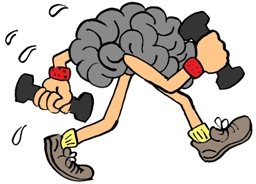Brain Power

A recent article in Vim & Vigor magazine (Fall 2010) entitled “Train your Brain” discusses how you can “start building a better brain today, no matter what your age.” The steps to a healthier brain listed in the article are sorted into the following five categories:
- Work It Out (Keeping blood flowing in the brain through physical exercise)
- Intellectual Interaction (Social interactions stimulate intellectual activity)
- Mental Stimulation (Learning new things and applying them “keep[s] your brain sharp”)
- Mental Relaxation (Relieving stress reduces Cortisol levels, which can be damaging to the brain)
- Food For Thought (Eating right helps your brain as well as your body)
At FasTracKids, we are committed to encouraging great brain health for every student. Participation in FasTracKids programs gives students the opportunity to experience at least four of the five categories.
Every FasTracKids lesson has a movement portion where students are encouraged to move around and get out of their seats. We understand that blood flow in the body equals blood flow in the mind, so it’s important that students are involved in physical activities.
Collaboration during projects and activities is required for a FasTracKids lesson. Interacting with fellow classmates can not only boost a student’s confidence, but it also stimulates the ability to learn from their peers.
Each of our lessons is designed to stretch each student’s comprehension ability by asking them to think in new ways. Questions and activities are created to be open-ended so that students find the answers themselves and not rely on teachers to tell them.
Fun activities, such as games and songs, are used in lessons to help reduce the stress of learning and encourage the participation of everyone.
The only category we don’t emphasize in every class is eating right, though we do have a lesson on good nutrition. As long as parents continue to feed their children balanced meals, FasTracKids can help in maintaining and encouraging a child’s healthy brain.

Leave a Reply